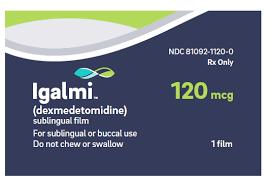Dexmedetomidine (injection)
Generic name: dexmedetomidine (injection) [ DEX-med-e-TOE-mi-deen ]
Brand name: Precedex
Dosage form: intravenous solution (100 mcg/mL; 4 mcg/mL; 4 mcg/mL-D5%; 4 mcg/mL-NaCl 0.9%)
Drug class: Miscellaneous anxiolytics, sedatives and hypnotics
What is dexmedetomidine injection?
Dexmedetomidine injection is used in adults to start or maintain sedation in people who are on a machine that helps with breathing (ventilator) in the intensive care unit (ICU).
Dexmedetomidine injection is used in adults for sedation before and during surgery or a medical procedure.
Dexmedetomidine injection is also used in children aged 1 months to less than 18 years of age for sedation before and during other medical procedures.
Dexmedetomidine injection may also be used for purposes not listed in this medication guide.
Dexmedetomidine injection side effects
Get emergency medical help if you have signs of an allergic reaction: hives, difficult breathing, swelling of your face, lips, tongue, or throat.
Certain side effects may occur during the first 48 hours after receiving dexmedetomidine injection. Tell your medical caregivers at once if you have: weakness, confusion, feeling nervous or agitated, increased sweating, weight loss, stomach pain, diarrhea, constipation, craving salty foods, dizziness, feeling light-head, and headache.
Dexmedetomidine may cause serious side effects. Call your doctor at once if you have:
-
fever with shortness of breath or rapid breathing.
Common side effects of dexmedetomidine may include:
-
slow heartbeats;
-
dry mouth; or
Some side effects are more common in children receiving dexmedetomidine injection such as slow breathing, high blood pressure.
This is not a complete list of side effects and others may occur. Call your doctor for medical advice about side effects. You may report side effects to FDA at 1-800-FDA-1088.
Related/similar drugs
Warnings
Use only as directed. Tell your doctor if you use other medicines or have other medical conditions or allergies.
Before taking this medicine
Tell your doctor if you have or have ever had:
-
diabetes;
-
high blood pressure;
-
a serious heart condition such as "AV block" (2nd or 3rd degree);
-
a heart rhythm disorder;
-
low blood pressure, if you are dehydrated; or
It is not known if dexmedetomidine injection will harm an unborn baby. Tell your doctor if you are pregnant or plan to become pregnant.
If you are breastfeeding, tell your doctor if you notice irritability in the nursing baby.
How is dexmedetomidine injection given?
Dexmedetomidine is injected into a vein by a healthcare provider.
Your breathing, heart rate, blood pressure, oxygen levels, and other vital signs will be watched closely during and after receiving dexmedetomidine injection.
Dexmedetomidine dosing information
Usual Adult Dose for Sedation:
Intensive Care Unit Sedation:
-Initial Dose: Loading dose of 1 mcg/kg IV infusion over 10 minutes.
-Maintenance Dose: 0.2 to 0.7 mcg/kg/hour IV infusion; adjust the infusion rate to achieve the desired clinical effect.
Procedural Sedation:
-Initial Dose (including Awake Fiberoptic Intubation): 1 mcg/kg IV infusion over 10 minutes.
-Maintenance Dose: Initiate IV infusion at 0.6 mcg/kg/hour and titrate to achieve the desired clinical effect; doses may range from 0.2 to 1 mcg/kg/hour.
Uses: Sedation of initially intubated and mechanically ventilated patients during treatment in an intensive care setting; sedation of non-intubated patients prior to and/or during surgical and other procedures.
Usual Geriatric Dose for Sedation:
Over Age 65 Years:
Intensive Care Unit Sedation: Dose reduction may be required; however, no specific guidelines have been suggested.
Procedural Sedation:
-Initial Dose: May be omitted or reduced (e.g., 0.5 mcg/kg IV infusion over 10 minutes).
-Maintenance Dose: Dose reduction may be required; however, no specific guidelines have been suggested.
Uses: Sedation of initially intubated and mechanically ventilated patients during treatment in an intensive care setting; sedation of non-intubated patients prior to and/or during surgical and other procedures.
What happens if I miss a dose?
In a medical setting you are not likely to miss a dose.
What happens if I overdose?
In a medical setting an overdose would be treated quickly.
What should I avoid after receiving dexmedetomidine injection?
Follow your doctor's instructions about any restrictions on food, beverages, or activity.
What other drugs will affect dexmedetomidine injection?
Using dexmedetomidine with other drugs that make you drowsy can worsen this effect. Ask your doctor before using opioid medication, a sleeping pill, a muscle relaxer, or medicine for anxiety or seizures.
Other drugs may affect dexmedetomidine, including prescription and over-the-counter medicines, vitamins, and herbal products. Tell your doctor about all other medicines you use.
More about dexmedetomidine
- Check interactions
- Compare alternatives
- Pricing & coupons
- Latest FDA alerts (2)
- Side effects
- Dosage information
- During pregnancy
- Drug class: miscellaneous anxiolytics, sedatives and hypnotics
- Breastfeeding
Patient resources
- Dexmedetomidine buccal/sublingual drug information
- Dexmedetomidine (Intravenous) (Advanced Reading)
- Dexmedetomidine (Oromucosal) (Advanced Reading)
- Dexmedetomidine
Other brands
Professional resources
- Dexmedetomidine Hydrochloride monograph
- Dexmedetomidine Hydrochloride Injection (FDA)
- Dexmedetomidine hydrochloride Injection, Concentrate (FDA)
- Dexmedetomidine in Sodium Chloride Injection (FDA)
Other brands
Related treatment guides
Further information
Remember, keep this and all other medicines out of the reach of children, never share your medicines with others, and use this medication only for the indication prescribed.
Always consult your healthcare provider to ensure the information displayed on this page applies to your personal circumstances.
Copyright 1996-2025 Cerner Multum, Inc. Version: 3.01.

